中英文文献翻译-仓库管理系统( WMS )
WMS仓储管理系统
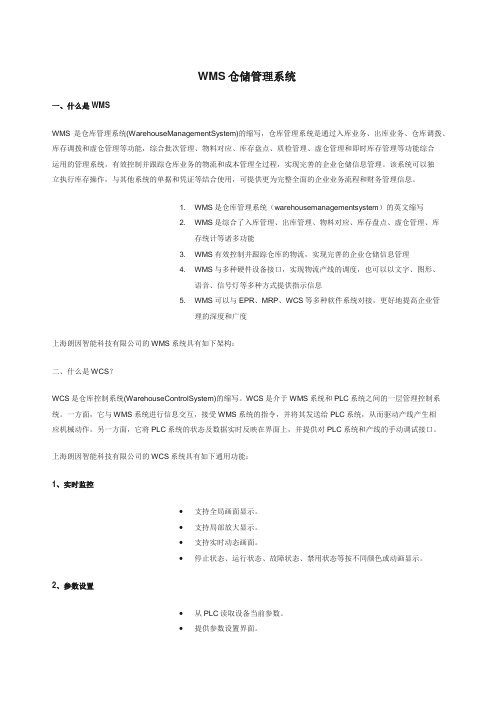
WMS仓储管理系统一、什么是WMSWMS是仓库管理系统(WarehouseManagementSystem)的缩写,仓库管理系统是通过入库业务、出库业务、仓库调拨、库存调拨和虚仓管理等功能,综合批次管理、物料对应、库存盘点、质检管理、虚仓管理和即时库存管理等功能综合运用的管理系统,有效控制并跟踪仓库业务的物流和成本管理全过程,实现完善的企业仓储信息管理。
该系统可以独立执行库存操作,与其他系统的单据和凭证等结合使用,可提供更为完整全面的企业业务流程和财务管理信息。
1. WMS是仓库管理系统(warehousemanagementsystem)的英文缩写2. WMS是综合了入库管理、出库管理、物料对应、库存盘点、虚仓管理、库存统计等诸多功能3. WMS有效控制并跟踪仓库的物流,实现完善的企业仓储信息管理4. WMS与多种硬件设备接口,实现物流产线的调度,也可以以文字、图形、语音、信号灯等多种方式提供指示信息5. WMS可以与EPR、MRP、WCS等多种软件系统对接,更好地提高企业管理的深度和广度上海朗因智能科技有限公司的WMS系统具有如下架构:二、什么是WCS?WCS是仓库控制系统(WarehouseControlSystem)的缩写。
WCS是介于WMS系统和PLC系统之间的一层管理控制系统。
一方面,它与WMS系统进行信息交互,接受WMS系统的指令,并将其发送给PLC系统,从而驱动产线产生相应机械动作。
另一方面,它将PLC系统的状态及数据实时反映在界面上,并提供对PLC系统和产线的手动调试接口。
上海朗因智能科技有限公司的WCS系统具有如下通用功能:1、实时监控•支持全局画面显示。
•支持局部放大显示。
•支持实时动态画面。
•停止状态、运行状态、故障状态、禁用状态等按不同颜色或动画显示。
2、参数设置•从PLC读取设备当前参数。
•提供参数设置界面。
•向PLC写入修改后的设备参数。
•支持参数初始化功能。
3、手动控制•提供输送线设备的启停、封解、复位、数据清除、初始化等控制功能。
中英文文献翻译-仓库管理系统( WMS )

英文原文Warehouse Management Systems (WMS).The evolution of warehouse management systems (WMS) is very similar to that of many other software solutions. Initially a system to control movement and storage of materials within a warehouse, the role of WMS is expanding to including light manufacturing, transportation management, order management, and complete accounting systems. To use the grandfather of operations-related software, MRP, as a comparison, material requirements planning (MRP) started as a system for planning raw material requirements in a manufacturing environment. Soon MRP evolved into manufacturing resource planning (MRPII), which took the basic MRP system and added scheduling and capacity planning logic. Eventually MRPII evolved into enterprise resource planning (ERP), incorporating all the MRPII functionality with full financials and customer and vendor management functionality. Now, whether WMS evolving into a warehouse-focused ERP system is a good thing or not is up to debate. What is clear is that the expansion of the overlap in functionality between Warehouse Management Systems, Enterprise Resource Planning, Distribution Requirements Planning, Transportation Management Systems, Supply Chain Planning, Advanced Planning and Scheduling, and Manufacturing Execution Systems will only increase the level of confusion among companies looking for software solutions for their operations.Even though WMS continues to gain added functionality, the initial core functionality of a WMS has not really changed. The primary purpose of a WMS is to control the movement and storage of materials within an operation and process the associated transactions. Directed picking, directed replenishment, and directed put away are the key to WMS. The detailed setup and processing within a WMS can vary significantly from one software vendor to another, however the basic logic will use a combination of item, location, quantity, unit of measure, and order information to determine where to stock, where to pick, and in what sequence to perform these operations.Have a flexible location system.Utilize user-defined parameters to direct warehouse tasks and use liveHave some built-in level of integration with data collection devices.Do You Really Need WMS?Not every warehouse needs a WMS. Certainly any warehouse could benefit from some of the functionality but is the benefit great enough to justify the initial and ongoing costs associated with WMS? Warehouse Management Systems are big, complex, data intensive, applications. They tend to require a lot of initial setup, a lot of system resources to run, and a lot of ongoing data management to con tinue to run. That’s right, you need to "manage" your warehouse "management" system. Often times, large operations will end up creating a new IS department with the sole responsibility of managing the WMS.The Claims:WMS will reduce inventory!WMS will reduce labor costs!WMS will increase storage capacity!WMS will increase customer service!WMS will increase inventory accuracy!The Reality:The implementation of a WMS along with automated data collection will likely give you increases in accuracy, reduction in labor costs (provided the labor required to maintain the system is less than the labor saved on the warehouse floor), and a greater ability to service the customer by reducing cycle times. Expectations of inventory reduction and increased storage capacity are less likely. While increased accuracy and efficiencies in the receiving process may reduce the level of safety stock required, the impact of this reduction will likely be negligible in comparison to overall inventory levels. The predominant factors that control inventory levels are lot sizing, lead times, and demand variability. It is unlikely that a WMS will have a significant impact on any of these factors. And while a WMS certainly provides the tools for more organized storage which may result in increased storage capacity, this improvement will be relative to just how sloppy your pre-WMS processes were.Beyond labor efficiencies, the determining factors in deciding to implement a WMS tend to be more often associated with the need to do something to service your customers that your current system does not support (or does not support well) such as first-in-first-out, cross-docking, automated pick replenishment, wave picking, lot tracking, yard management, automated data collection, automated material handling equipment, etc.SetupThe setup requirements of WMS can be extensive. The characteristics of each item and location must be maintained either at the detail level or by grouping similar items and locationsinto categories. An example of item characteristics at the detail level would include exact dimensions and weight of each item in each unit of measure the item is stocked (each, cases, pallets, etc) as well as information such as whether it can be mixed with other items in a location, whether it is rack able, max stack height, max quantity per location, hazard classifications, finished goods or raw material, fast versus slow mover, etc. Although some operations will need to set up each item this way, most operations will benefit by creating groups of similar products. For example, if you are a distributor of music CDs you would create groups for single CDs, and double CDs, maintaining the detailed dimension and weight information at the group level and only needing to attach the group code to each item. You would likely need to maintain detailed information on special items such as boxed sets or CDs in special packaging. You would also create groups for the different types of locations within your warehouse. An example would be to create three different groups (P1, P2, P3) for the three different sized forward picking locations you use for your CD picking. You then set up the quantity of single CDs that will fit in a P1, P2, and P3 location, quantity of double CDs that fit in a P1, P2, P3 location etc. You would likely also be setting up case quantities, and pallet quantities of each CD group and quantities of cases and pallets per each reserve storage location group.If this sounds simple, it is…well… sort of. In reality most operations have a much more diverse product mix and will require much more system setup. And setting up the physical characteristics of the product and locations is only part of the picture. You have set up enough so that the system knows where a product can fit and how many will fit in that location. You now need to set up the information needed to let the system decide exactly which location to pick from, replenish from/to, and put away to, and in what sequence these events should occur (remember WMS is all about “directed” movement). You do this by assigni ng specific logic to the various combinations of item/order/quantity/location information that will occur.Below I have listed some of the logic used in determining actual locations and sequences.Location Sequence. This is the simplest logic; you simply define a flow through your warehouse and assign a sequence number to each location. In order picking this is used to sequence your picks to flow through the warehouse, in put away the logic would look for the first location in the sequence in which the product would fit.Zone Logic. By breaking down your storage locations into zones you can direct picking, put away, or replenishment to or from specific areas of your warehouse. Since zone logic only designates an area, you will need to combine this with some other type of logic to determine exact location within the zone.Fixed Location. Logic uses predetermined fixed locations per item in picking, put away, and replenishment. Fixed locations are most often used as the primary picking location in piece pick and case-pick operations, however, they can also be used for secondary storage.Random Location. Since computers cannot be truly random (nor would you want them to be) the term random location is a little misleading. Random locations generally refer to areas where products are not stored in designated fixed locations. Like zone logic, you will need some additional logic to determine exact locations.First-in-first-out (FIFO).Directs picking from the oldest inventory first.Last-in-first-out (LIFO).Opposite of FIFO. I didn't think there were any real applications for this logic until a visitor to my site sent an email describing their operation that distributes perishable goods domestically and overseas. They use LIFO for their overseas customers (because of longer in-transit times) and FIFO for their domestic customers.Pick-to-clear. Logic directs picking to the locations with the smallest quantities on hand. This logic is great for space utilization.Reserved Locations. This is used when you want to predetermine specific locations to put away to or pick from. An application for reserved locations would be cross-docking, where you may specify certain quantities of an inbound shipment be moved to specific outbound staging locations or directly to an awaiting outbound trailer.Maximize Cube. Cube logic is found in most WMS systems however it is seldom used. Cube logic basically uses unit dimensions to calculate cube (cubic inches per unit) and then compares this to the cube capacity of the location to determine how much will fit. Now if the units are capable of being stacked into the location in a manner that fills every cubic inch of space in the location, cube logic will work. Since this rarely happens in the real world, cube logic tends to be impractical.Consolidate. Looks to see if there is already a location with the same product stored in it with available capacity. May also create additional moves to consolidate like product stored in multiple locations.Lot Sequence. Used for picking or replenishment, this will use the lot number or lot date to determine locations to pick from or replenish from.It’s very common to combine multiple logic methods to determine the best location. For example you may chose to use pick-to-clear logic within first-in-first-out logic when there are multiple locations with the same receipt date. You also may change the logic based upon current workload. During busy periods you may chose logic that optimizes productivity while during slower periods you switch to logic that optimizes space utilization.Other Functionality/ConsiderationsWave Picking/Batch Picking/Zone Picking. Support for various picking methods varies from one system to another. In high-volume fulfillment operations, picking logic can be a critical factor in WMS selection. See my article on Order Picking for more info on these methods.Task Interleaving. Task interleaving describes functionality that mixes dissimilar tasks such as picking and put away to obtain maximum productivity. Used primarily in full-pallet-load operations, task interleaving will direct a lift truck operator to put away a pallet on his/her way to the next pick. In large warehouses this can greatly reduce travel time, not only increasing productivity, but also reducing wear on the lift trucks and saving on energy costs by reducing lift truck fuel consumption. Task interleaving is also used with cycle counting programs to coordinate a cycle count with a picking or put away task.Integration with Automated Material Handling Equipment. If you are planning on using automated material handling equipment such as carousels, ASRS units, AGNS, pick-to-light systems, or separation systems, you’ll wa nt to consider this during the software selection process. Since these types of automation are very expensive and are usually a core component of your warehouse, you may find that the equipment will drive the selection of the WMS. As with automated data collection, you should be working closely with the equipment manufacturers during the software selection process.Advanced Shipment Notifications (ASN). If your vendors are capable of sending advanced shipment notifications (preferably electronically) and attaching compliance labels to the shipments you will want to make sure that the WMS can use this to automate your receiving process. In addition, if you have requirements to provide ASNs for customers, you will also want to verify this functionality.Yard Management. Yard management describes the function of managing the contents (inventory) of trailers parked outside the warehouse, or the empty trailers themselves. Yard management is generally associated with cross docking operations and may include the management of both inbound and outbound trailers.Labor Tracking/Capacity Planning. Some WMS systems provide functionality related to labor reporting and capacity planning. Anyone that has worked in manufacturing should be familiar with this type of logic. Basically, you set up standard labor hours and machine (usually lift trucks) hours per task and set the available labor and machine hours per shift. The WMS system will use this info to determine capacity and load. Manufacturing has been using capacity planning for decades with mixed results. The need to factor in efficiency and utilization to determine rated capacity is an example of the shortcomings of this process. Not that I’m necessarily against capacity planning in warehousing, I just think most operations don’t really need it and can avoid the disappointment of trying to make it work. I am, however, a bigadvocate of labor tracking for individual productivity measurement. Most WMS maintain enough data to create productivity reporting. Since productivity is measured differently from one operation to another you can assume you will have to do some minor modifications here (usually in the form of custom reporting).Integration with existing accounting/ERP systems. Unless the WMS vendor has already created a specific interface with your accounting/ERP system (such as those provided by an approved business partner) you can expect to spend some significant programming dollars here. While we are all hoping that integration issues will be magically resolved someday by a standardized interface, we isn’t there yet. Ideally you’ll want an integrator that has already integrated the WMS you chose with the business software you are using. Since this is not always possible you at least want an integrator that is very familiar with one of the systems.WMS + everything else = ? As I mentioned at the beginning of this article, a lot of other modules are being added to WMS packages. These would include full financials, light manufacturing, transportation management, purchasing, and sales order management. I don’t see this as a unilateral move of WMS from an add-on module to a core system, but rather an optional approach that has applications in specific industries such as 3PLs. Using ERP systems as a point of reference, it is unlikely that this add-on functionality will match the functionality ofbest-of-breed applications available separately. If warehousing/distribution is your core business function and you don’t want to have to deal with the integration issues of incorporating separate financials, order processing, etc. you may find these WMS based business systems are a good fit.Implementation TipsOutside of the standard “don’t underestimate”, “thoroughly test”, “train, train, train” implementation tips that apply to any business software installation ,it’s important to emphasize that WMS are very data dependent and restrictive by design. That is, you need to have all of the various data elements in place for the system to function properly. And, when they are in place, you must operate within the set parameters.When implementing a WMS, you are adding an additional layer of technology onto your system. And with each layer of technology there is additional overhead and additional sources of potential problems. Now don’t take this as a condemnation of Warehouse Management Systems. Coming from a warehousing background I definitely appreciate the functionality WMS have to offer, and, in many warehouses, this functionality is essential to their ability to serve their customers and remain competitive. It’s just important to note that every solution has its downsides and having a good understanding of the potential implications will allow managers to make better decisions related to the levels of technology that best suits their unique environment.中文译文仓库管理系统( WMS )仓库管理系统( WMS )的演变与许多其他软件解决方案是很像的。
仓储专用术语中英文对照
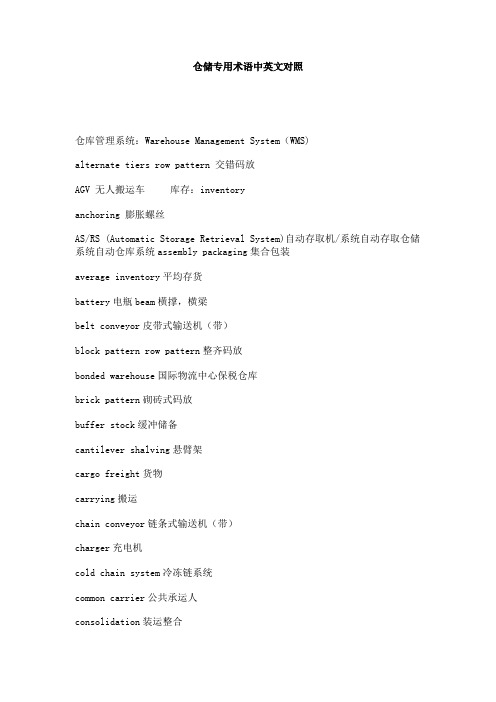
仓储专用术语中英文对照仓库管理系统:Warehouse Management System(WMS)alternate tiers row pattern 交错码放AGV 无人搬运车库存:inventoryanchoring 膨胀螺丝AS/RS (Automatic Storage Retrieval System)自动存取机/系统自动存取仓储系统自动仓库系统assembly packaging集合包装average inventory平均存货battery电瓶beam橫撑,横梁belt conveyor皮带式输送机(带)block pattern row pattern整齐码放bonded warehouse国际物流中心保税仓库brick pattern砌砖式码放buffer stock缓冲储备cantilever shalving悬臂架cargo freight货物carrying搬运chain conveyor链条式输送机(带)charger充电机cold chain system冷冻链系统common carrier公共承运人consolidation装运整合container terminal集装箱中转站contract carrier契约承运人contract logistics契约物流counterbalance truck平衡式电动(柴油、电动、瓦斯)堆高机cycle inventory周期存货delivery配送depalletizer托盘拆垛机devanning拆箱diagonal bracing斜撑dock leveller月台调整板dock shelter月台门封(充气式,非充气式)double-deep pallet racking双层深式重型物料钢架drive-in pallet racking直入式重型物料钢架dry cargo干货dunnage填充electronic data interchange电子资料交换EDIexport processing zone加工出口区fill rate供应比率floor utilization percentage地面面积利用率flow(dynamic) racking重型流力架flow(dynamic) rack shelving轻型(料盒、纸箱)流力架forklift truck叉车four-way reach truck四向式电动堆高机frame支柱组frame feet脚底板frame joint柱连杆freight container货物集装箱general cargo一般货物hand pallet truck油压拖板车horizontal bracing橫撑industrial door工业门industrial vehicle工业车辆intermodal transportation复合一贯运输lashing捆扎加固levelling plate垫片LGV激光引导无人搬运车load efficient装载效率loading and unloading装卸logistical utilities物流效用logistics物流materials handling物料搬运mezzanines floor积层架mini-load AS/RS料盒式自动仓库系統mobile dock leveller月台桥板mobile shelving移动柜net unit load size净单元货载尺寸operation area理货区order picking truck电动拣料车order picking指令拣选order shipped complete订货完成率packaged cargo包装货物packaging包装pallet托盘,(木质)栈板pallet container栈板笼架pallet pool system通用托盘系统pallet racking传统式重型物料钢架palletization托盘化palletizer托盘堆垛机palletizing pattern托盘装载方式pick up货物聚集picking拣货,拣选作业pictorial marking for handling货运标识pinwheel pattern针轮式码放plan view size平面尺寸plastic bin物料盒plastic pallet塑胶栈板platform物流容器,站台,月台physical distribution model物流标准powered pallet truck电动拖板车powered stacker自走式电动堆高机push-back pallet racking后推式重型物料钢架rack货架rack notice标示牌reach truck前伸式电动堆高机returnable container通用容器roll container笼车roller conveyor滚筒式输送机(带)safety pin插销safety stock安全储备scrubber洗地机shed临时周转仓库shelving轻量型物料钢架shuttle car梭车slat conveyor条板式输送机(带)slotted-angle shelving角钢架sorting分类special cargo特殊货物spot stock现场储备stacker crane自动存取机高架吊车stacking堆垛stockout frequency缺货频率storage存储support bar跨梁surface utilization percentage表面利用率sweeper扫地机table trolley物流台车third part logistics第三方物流third party logistics service provider第三方物流服务商transit inventory中转存货transportation运输transportation package size by modular coordination运输包装系列尺寸tray conveyor盘式输送机(带)truck terminal卡车货运站turntable转盘(变更输送方向)unit load单元货载unit load system单元货载系统upright支柱upright protctors护脚value added network—VAN加值网络vanning装箱vertical conveyor垂直输送机very narrow aisle truck窄巷道电动堆高机warehouse仓库WCS (Warehouse Control System)仓储控制系统WMS (Warehouse Management System)仓储管理系统。
仓储管理系统(wms)

仓储管理系统(WMS)1. 简介仓储管理系统(Warehouse Management System, WMS)是一种用于支持和优化仓储和物流操作的软件系统。
它涵盖了仓库的各个方面,包括货物存储、配送管理、库存控制和货物跟踪等。
该系统可以有效地管理仓库的运作,提高库存、配送和存储的效率,降低成本和风险。
2. 功能2.1 货物管理仓储管理系统可以追踪和管理货物的所有信息,包括到货时间、货物规格、数量和位置等。
用户可以通过该系统轻松找到所需货物,并通过条码或RFID技术进行货物的标识和追踪。
2.2 库存控制WMS系统可以帮助仓库管理员有效地控制和管理库存。
它可以自动更新库存信息,及时提醒用户货物的数量和位置,并在库存低于设定值时触发采购请求。
2.3 入库和出库管理仓储管理系统可以帮助用户跟踪和管理入库和出库操作。
它可以记录货物的进出时间、数量和目的地,并提供实时的货物跟踪和配送报告。
2.4 仓库布局优化WMS系统可以通过数据分析和智能算法来优化仓库的布局。
它可以根据货物的属性和需求,自动规划货架和货物的存放位置,以减少行程和提高仓库的工作效率。
2.5 周期性盘点仓储管理系统可以定期进行库存盘点,并生成准确的库存报告。
它可以帮助用户检查和纠正可能的库存错误,提高库存准确性和可信度。
2.6 运输管理WMS系统可以管理货物的运输和配送。
它可以自动计算最佳的路线和配送方案,减少运输成本和时间。
同时,它还可以追踪货物的运输过程,提供实时的货物位置信息,并及时通知用户货物的配送状态。
2.7 报告和分析仓储管理系统可以生成各种报告和分析,包括库存报告、运输报告、货物跟踪报告和仓库工作效率报告等。
这些报告可以帮助用户更好地了解仓库运作的状况,并作出相应的改进措施。
3. 优势3.1 提高工作效率仓储管理系统可以简化和自动化仓库操作,提高工作效率。
它可以帮助用户更快速地找到货物并完成入库、出库和配送等操作,减少员工的等待和重复工作。
(完整word版)仓储专用术语中英文对照

(完整word版)仓储专用术语中英文对照仓储专用术语中英文对照仓库管理系统:Warehouse Management System(WMS)alternate tiers row pattern 交错码放AGV 无人搬运车库存:inventoryanchoring 膨胀螺丝AS/RS (Automatic Storage Retrieval System)自动存取机/系统自动存取仓储系统自动仓库系统assembly packaging集合包装average inventory平均存货battery电瓶beam橫撑,横梁belt conveyor皮带式输送机(带)block pattern row pattern整齐码放bonded warehouse国际物流中心保税仓库brick pattern砌砖式码放buffer stock缓冲储备cantilever shalving悬臂架cargo freight货物(完整word版)仓储专用术语中英文对照carrying搬运chain conveyor链条式输送机(带)charger充电机cold chain system冷冻链系统common carrier公共承运人consolidation装运整合container terminal集装箱中转站contract carrier契约承运人contract logistics契约物流counterbalance truck平衡式电动(柴油、电动、瓦斯)堆高机cycle inventory周期存货delivery配送depalletizer托盘拆垛机devanning拆箱diagonal bracing斜撑dock leveller月台调整板dock shelter月台门封(充气式,非充气式)double-deep pallet racking双层深式重型物料钢架drive-in pallet racking直入式重型物料钢架dry cargo干货dunnage填充electronic data interchange电子资料交换EDIexport processing zone加工出口区fill rate供应比率floor utilization percentage地面面积利用率flow(dynamic) racking重型流力架flow(dynamic) rack shelving轻型(料盒、纸箱)流力架forklift truck叉车four-way reach truck四向式电动堆高机frame支柱组frame feet脚底板frame joint柱连杆freight container货物集装箱general cargo一般货物hand pallet truck油压拖板车horizontal bracing橫撑industrial door工业门industrial vehicle工业车辆intermodal transportation复合一贯运输lashing捆扎加固levelling plate垫片LGV激光引导无人搬运车load efficient装载效率loading and unloading装卸logistical utilities物流效用logistics物流materials handling物料搬运mezzanines floor积层架mini—load AS/RS料盒式自动仓库系統mobile dock leveller月台桥板mobile shelving移动柜net unit load size净单元货载尺寸operation area理货区order picking truck电动拣料车order picking指令拣选order shipped complete订货完成率packaged cargo包装货物packaging包装pallet托盘,(木质)栈板pallet container栈板笼架pallet pool system通用托盘系统pallet racking传统式重型物料钢架palletization托盘化palletizer托盘堆垛机palletizing pattern托盘装载方式pick up货物聚集picking拣货,拣选作业pictorial marking for handling货运标识pinwheel pattern针轮式码放plan view size平面尺寸plastic bin物料盒plastic pallet塑胶栈板platform物流容器,站台,月台physical distribution model物流标准powered pallet truck电动拖板车powered stacker自走式电动堆高机push-back pallet racking后推式重型物料钢架rack货架rack notice标示牌reach truck前伸式电动堆高机returnable container通用容器roll container笼车roller conveyor滚筒式输送机(带)safety pin插销safety stock安全储备scrubber洗地机shed临时周转仓库shelving轻量型物料钢架shuttle car梭车slat conveyor条板式输送机(带)slotted-angle shelving角钢架sorting分类special cargo特殊货物spot stock现场储备stacker crane自动存取机高架吊车stacking堆垛stockout frequency缺货频率storage存储support bar跨梁surface utilization percentage表面利用率sweeper扫地机table trolley物流台车third part logistics第三方物流third party logistics service provider第三方物流服务商transit inventory中转存货transportation运输transportation package size by modular coordination运输包装系列尺寸tray conveyor盘式输送机(带)truck terminal卡车货运站turntable转盘(变更输送方向)unit load单元货载unit load system单元货载系统upright支柱upright protctors护脚value added network—VAN加值网络vanning装箱vertical conveyor垂直输送机very narrow aisle truck窄巷道电动堆高机warehouse仓库WCS (Warehouse Control System)仓储控制系统WMS (Warehouse Management System)仓储管理系统。
仓储专用术语中英文

仓库管理系统:Warehouse Management System(WMS)alternate tiers row pattern 交错码放AGV 无人搬运车库存:inventoryanchoring 膨胀螺丝AS/RS (Automatic Storage Retrieval System)自动存取机/系统自动存取仓储系统自动仓库系统assembly packaging集合包装average inventory平均存货battery电瓶beam橫撑,横梁belt conveyor皮带式输送机(带)block pattern row pattern整齐码放bonded warehouse国际物流中心保税仓库brick pattern砌砖式码放buffer stock缓冲储备cantilever shalving悬臂架cargo freight货物carrying搬运chain conveyor链条式输送机(带)charger充电机cold chain system冷冻链系统common carrier公共承运人consolidation装运整合container terminal集装箱中转站contract carrier契约承运人contract logistics契约物流counterbalance truck平衡式电动(柴油、电动、瓦斯)堆高机cycle inventory周期存货delivery配送depalletizer托盘拆垛机devanning拆箱diagonal bracing斜撑dock leveller月台调整板dock shelter月台门封(充气式,非充气式)double-deep pallet racking双层深式重型物料钢架drive-in pallet racking直入式重型物料钢架dry cargo干货dunnage填充electronic data interchange电子资料交换EDIexport processing zone加工出口区fill rate供应比率floor utilization percentage地面面积利用率flow(dynamic) racking重型流力架flow(dynamic) rack shelving轻型(料盒、纸箱)流力架forklift truck叉车four-way reach truck四向式电动堆高机frame支柱组frame feet脚底板frame joint柱连杆freight container货物集装箱general cargo一般货物hand pallet truck油压拖板车horizontal bracing橫撑industrial door工业门industrial vehicle工业车辆intermodal transportation复合一贯运输lashing捆扎加固levelling plate垫片LGV激光引导无人搬运车load efficient装载效率loading and unloading装卸logistical utilities物流效用logistics物流materials handling物料搬运mezzanines floor积层架mini-load AS/RS料盒式自动仓库系統mobile dock leveller月台桥板mobile shelving移动柜net unit load size净单元货载尺寸operation area理货区order picking truck电动拣料车order picking指令拣选order shipped complete订货完成率packaged cargo包装货物packaging包装pallet托盘,(木质)栈板pallet container栈板笼架pallet pool system通用托盘系统pallet racking传统式重型物料钢架palletization托盘化palletizer托盘堆垛机palletizing pattern托盘装载方式pick up货物聚集picking拣货,拣选作业pictorial marking for handling货运标识pinwheel pattern针轮式码放plan view size平面尺寸plastic bin物料盒plastic pallet塑胶栈板platform物流容器,站台,月台physical distribution model物流标准powered pallet truck电动拖板车powered stacker自走式电动堆高机push-back pallet racking后推式重型物料钢架rack货架rack notice标示牌reach truck前伸式电动堆高机returnable container通用容器roll container笼车roller conveyor滚筒式输送机(带)safety pin插销safety stock安全储备scrubber洗地机shed临时周转仓库shelving轻量型物料钢架shuttle car梭车slat conveyor条板式输送机(带)slotted-angle shelving角钢架sorting分类special cargo特殊货物spot stock现场储备stacker crane自动存取机高架吊车stacking堆垛stockout frequency缺货频率storage存储support bar跨梁surface utilization percentage表面利用率sweeper扫地机table trolley物流台车third part logistics第三方物流third party logistics service provider第三方物流服务商transit inventory中转存货transportation运输transportation package size by modular coordination运输包装系列尺寸tray conveyor盘式输送机(带)truck terminal卡车货运站turntable转盘(变更输送方向)unit load单元货载unit load system单元货载系统upright支柱upright protctors护脚value added network—VAN加网络vanning装箱vertical conveyor垂直输送机very narrow aisle truck窄巷道电动堆高机warehouse仓库WCS (Warehouse Control System)仓储控制系统WMS (Warehouse Management System)仓储管理系统欢迎您的下载,资料仅供参考!致力为企业和个人提供合同协议,策划案计划书,学习资料等等打造全网一站式需求。
WMS仓储管理系统
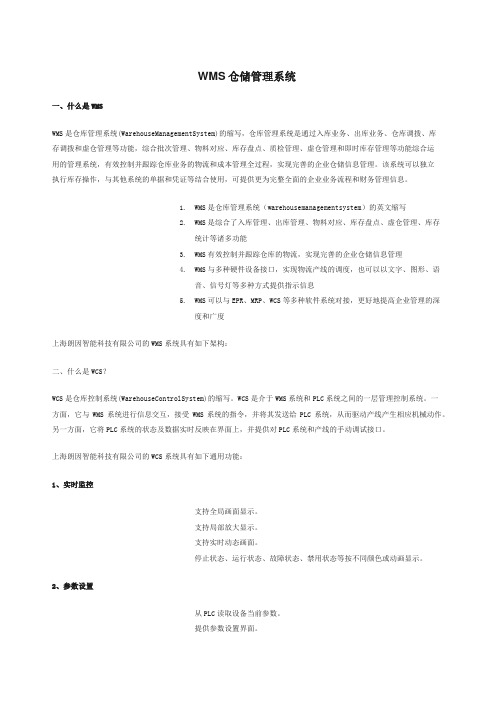
WMS仓储管理系统一、什么是WMSWMS是仓库管理系统(WarehouseManagementSystem)的缩写,仓库管理系统是通过入库业务、出库业务、仓库调拨、库存调拨和虚仓管理等功能,综合批次管理、物料对应、库存盘点、质检管理、虚仓管理和即时库存管理等功能综合运用的管理系统,有效控制并跟踪仓库业务的物流和成本管理全过程,实现完善的企业仓储信息管理。
该系统可以独立执行库存操作,与其他系统的单据和凭证等结合使用,可提供更为完整全面的企业业务流程和财务管理信息。
1.WMS是仓库管理系统(warehousemanagementsystem)的英文缩写2.WMS是综合了入库管理、出库管理、物料对应、库存盘点、虚仓管理、库存统计等诸多功能3.WMS有效控制并跟踪仓库的物流,实现完善的企业仓储信息管理4.WMS与多种硬件设备接口,实现物流产线的调度,也可以以文字、图形、语音、信号灯等多种方式提供指示信息5.WMS可以与EPR、MRP、WCS等多种软件系统对接,更好地提高企业管理的深度和广度上海朗因智能科技有限公司的WMS系统具有如下架构:二、什么是WCS?WCS是仓库控制系统(WarehouseControlSystem)的缩写。
WCS是介于WMS系统和PLC系统之间的一层管理控制系统。
一方面,它与WMS系统进行信息交互,接受WMS系统的指令,并将其发送给PLC系统,从而驱动产线产生相应机械动作。
另一方面,它将PLC系统的状态及数据实时反映在界面上,并提供对PLC系统和产线的手动调试接口。
上海朗因智能科技有限公司的WCS系统具有如下通用功能:1、实时监控支持全局画面显示。
支持局部放大显示。
支持实时动态画面。
停止状态、运行状态、故障状态、禁用状态等按不同颜色或动画显示。
2、参数设置从PLC读取设备当前参数。
提供参数设置界面。
向PLC写入修改后的设备参数。
支持参数初始化功能。
3、手动控制提供输送线设备的启停、封解、复位、数据清除、初始化等控制功能。
WMS仓储管理系统
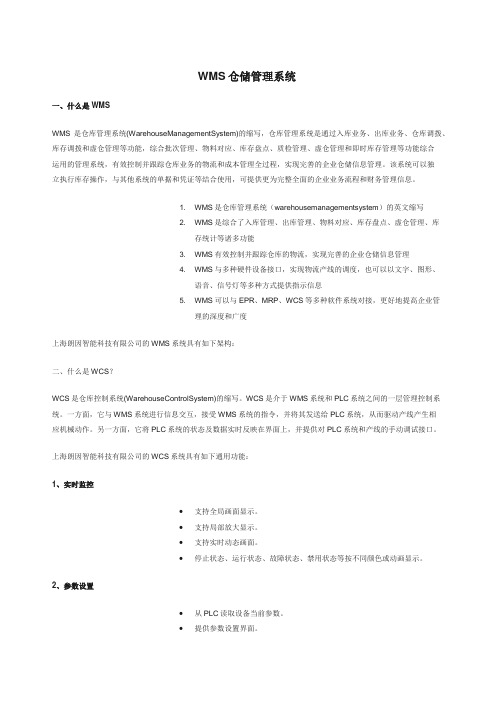
WMS仓储管理系统一、什么是WMSWMS是仓库管理系统(WarehouseManagementSystem)的缩写,仓库管理系统是通过入库业务、出库业务、仓库调拨、库存调拨和虚仓管理等功能,综合批次管理、物料对应、库存盘点、质检管理、虚仓管理和即时库存管理等功能综合运用的管理系统,有效控制并跟踪仓库业务的物流和成本管理全过程,实现完善的企业仓储信息管理。
该系统可以独立执行库存操作,与其他系统的单据和凭证等结合使用,可提供更为完整全面的企业业务流程和财务管理信息。
1. WMS是仓库管理系统(warehousemanagementsystem)的英文缩写2. WMS是综合了入库管理、出库管理、物料对应、库存盘点、虚仓管理、库存统计等诸多功能3. WMS有效控制并跟踪仓库的物流,实现完善的企业仓储信息管理4. WMS与多种硬件设备接口,实现物流产线的调度,也可以以文字、图形、语音、信号灯等多种方式提供指示信息5. WMS可以与EPR、MRP、WCS等多种软件系统对接,更好地提高企业管理的深度和广度上海朗因智能科技有限公司的WMS系统具有如下架构:二、什么是WCS?WCS是仓库控制系统(WarehouseControlSystem)的缩写。
WCS是介于WMS系统和PLC系统之间的一层管理控制系统。
一方面,它与WMS系统进行信息交互,接受WMS系统的指令,并将其发送给PLC系统,从而驱动产线产生相应机械动作。
另一方面,它将PLC系统的状态及数据实时反映在界面上,并提供对PLC系统和产线的手动调试接口。
上海朗因智能科技有限公司的WCS系统具有如下通用功能:1、实时监控•支持全局画面显示。
•支持局部放大显示。
•支持实时动态画面。
•停止状态、运行状态、故障状态、禁用状态等按不同颜色或动画显示。
2、参数设置•从PLC读取设备当前参数。
•提供参数设置界面。
•向PLC写入修改后的设备参数。
•支持参数初始化功能。
3、手动控制•提供输送线设备的启停、封解、复位、数据清除、初始化等控制功能。
仓库管理系统英文的参考文献

仓库管理系统英文的参考文献英文回答:Warehouse Management System (WMS)。
A warehouse management system (WMS) is a software application that supports the day-to-day operations of a warehouse. It helps businesses keep track of their inventory, manage their warehouse space, and optimize their shipping and receiving processes.Benefits of using a WMS:Improved inventory accuracy.Reduced labor costs.Increased warehouse space utilization.Improved customer service.Reduced shipping costs.Features of a WMS:Inventory management.Warehouse space management.Shipping and receiving management. Reporting and analytics.Types of WMS:On-premise WMS.Cloud-based WMS.Hybrid WMS.Choosing the right WMS:When choosing a WMS, businesses should consider the following factors:The size and complexity of their warehouse.The volume of inventory they manage.Their shipping and receiving requirements.Their budget.Their IT resources.Implementation of a WMS:Implementing a WMS can be a complex process. However, with careful planning and execution, businesses can reap the many benefits that a WMS has to offer.中文回答:仓库管理系统 (WMS)。
仓储专用术语中英文

仓库管理系统:Warehouse Management System(WMS)alternate tiers row pattern 交错码放AGV 无人搬运车库存:inventoryanchoring 膨胀螺丝AS/RS (Automatic Storage Retrieval System)自动存取机/系统自动存取仓储系统自动仓库系统assembly packaging集合包装average inventory平均存货battery电瓶beam橫撑,横梁belt conveyor皮带式输送机(带)block pattern row pattern整齐码放bonded warehouse国际物流中心保税仓库brick pattern砌砖式码放buffer stock缓冲储备cantilever shalving悬臂架cargo freight货物carrying搬运chain conveyor链条式输送机(带)charger充电机cold chain system冷冻链系统common carrier公共承运人consolidation装运整合container terminal集装箱中转站contract carrier契约承运人contract logistics契约物流counterbalance truck平衡式电动(柴油、电动、瓦斯)堆高机cycle inventory周期存货delivery配送depalletizer托盘拆垛机devanning拆箱diagonal bracing斜撑dock leveller月台调整板dock shelter月台门封(充气式,非充气式)double-deep pallet racking双层深式重型物料钢架drive-in pallet racking直入式重型物料钢架dry cargo干货dunnage填充electronic data interchange电子资料交换EDIexport processing zone加工出口区fill rate供应比率floor utilization percentage地面面积利用率flow(dynamic) racking重型流力架flow(dynamic) rack shelving轻型(料盒、纸箱)流力架forklift truck叉车four-way reach truck四向式电动堆高机frame支柱组frame feet脚底板frame joint柱连杆freight container货物集装箱general cargo一般货物hand pallet truck油压拖板车horizontal bracing橫撑industrial door工业门industrial vehicle工业车辆intermodal transportation复合一贯运输lashing捆扎加固levelling plate垫片LGV激光引导无人搬运车load efficient装载效率loading and unloading装卸logistical utilities物流效用logistics物流materials handling物料搬运mezzanines floor积层架mini-load AS/RS料盒式自动仓库系統mobile dock leveller月台桥板mobile shelving移动柜net unit load size净单元货载尺寸operation area理货区order picking truck电动拣料车order picking指令拣选order shipped complete订货完成率packaged cargo包装货物packaging包装pallet托盘,(木质)栈板pallet container栈板笼架pallet pool system通用托盘系统pallet racking传统式重型物料钢架palletization托盘化palletizer托盘堆垛机palletizing pattern托盘装载方式pick up货物聚集picking拣货,拣选作业pictorial marking for handling货运标识pinwheel pattern针轮式码放plan view size平面尺寸plastic bin物料盒plastic pallet塑胶栈板platform物流容器,站台,月台physical distribution model物流标准powered pallet truck电动拖板车powered stacker自走式电动堆高机push-back pallet racking后推式重型物料钢架rack货架rack notice标示牌reach truck前伸式电动堆高机returnable container通用容器roll container笼车roller conveyor滚筒式输送机(带)safety pin插销safety stock安全储备scrubber洗地机shed临时周转仓库shelving轻量型物料钢架shuttle car梭车slat conveyor条板式输送机(带)slotted-angle shelving角钢架sorting分类special cargo特殊货物spot stock现场储备stacker crane自动存取机高架吊车stacking堆垛stockout frequency缺货频率storage存储support bar跨梁surface utilization percentage表面利用率sweeper扫地机table trolley物流台车third part logistics第三方物流third party logistics service provider第三方物流服务商transit inventory中转存货transportation运输transportation package size by modular coordination运输包装系列尺寸tray conveyor盘式输送机(带)truck terminal卡车货运站turntable转盘(变更输送方向)unit load单元货载unit load system单元货载系统upright支柱upright protctors护脚value added network—VAN加网络vanning装箱vertical conveyor垂直输送机very narrow aisle truck窄巷道电动堆高机warehouse仓库WCS (Warehouse Control System)仓储控制系统WMS (Warehouse Management System)仓储管理系统。
仓储专用术语中英文
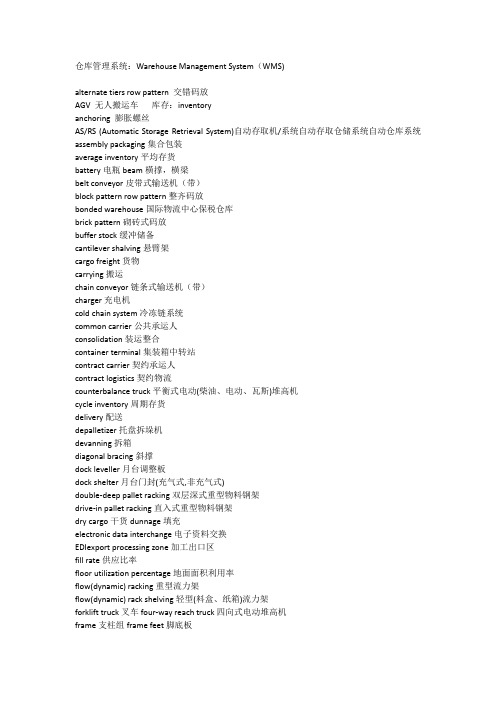
仓库管理系统:Warehouse Management System(WMS)alternate tiers row pattern 交错码放AGV 无人搬运车库存:inventoryanchoring 膨胀螺丝AS/RS (Automatic Storage Retrieval System)自动存取机/系统自动存取仓储系统自动仓库系统assembly packaging集合包装average inventory平均存货battery电瓶beam橫撑,横梁belt conveyor皮带式输送机(带)block pattern row pattern整齐码放bonded warehouse国际物流中心保税仓库brick pattern砌砖式码放buffer stock缓冲储备cantilever shalving悬臂架cargo freight货物carrying搬运chain conveyor链条式输送机(带)charger充电机cold chain system冷冻链系统common carrier公共承运人consolidation装运整合container terminal集装箱中转站contract carrier契约承运人contract logistics契约物流counterbalance truck平衡式电动(柴油、电动、瓦斯)堆高机cycle inventory周期存货delivery配送depalletizer托盘拆垛机devanning拆箱diagonal bracing斜撑dock leveller月台调整板dock shelter月台门封(充气式,非充气式)double-deep pallet racking双层深式重型物料钢架drive-in pallet racking直入式重型物料钢架dry cargo干货dunnage填充electronic data interchange电子资料交换EDIexport processing zone加工出口区fill rate供应比率floor utilization percentage地面面积利用率flow(dynamic) racking重型流力架flow(dynamic) rack shelving轻型(料盒、纸箱)流力架forklift truck叉车four-way reach truck四向式电动堆高机frame支柱组frame feet脚底板frame joint柱连杆freight container货物集装箱general cargo一般货物hand pallet truck油压拖板车horizontal bracing橫撑industrial door工业门industrial vehicle工业车辆intermodal transportation复合一贯运输lashing捆扎加固levelling plate垫片LGV激光引导无人搬运车load efficient装载效率loading and unloading装卸logistical utilities物流效用logistics物流materials handling物料搬运mezzanines floor积层架mini-load AS/RS料盒式自动仓库系統mobile dock leveller月台桥板mobile shelving移动柜net unit load size净单元货载尺寸operation area理货区order picking truck电动拣料车order picking指令拣选order shipped complete订货完成率packaged cargo包装货物packaging包装pallet托盘,(木质)栈板pallet container栈板笼架pallet pool system通用托盘系统pallet racking传统式重型物料钢架palletization托盘化palletizer托盘堆垛机palletizing pattern托盘装载方式pick up货物聚集picking拣货,拣选作业pictorial marking for handling货运标识pinwheel pattern针轮式码放plan view size平面尺寸plastic bin物料盒plastic pallet塑胶栈板platform物流容器,站台,月台physical distribution model物流标准powered pallet truck电动拖板车powered stacker自走式电动堆高机push-back pallet racking后推式重型物料钢架rack货架rack notice标示牌reach truck前伸式电动堆高机returnable container通用容器roll container笼车roller conveyor滚筒式输送机(带)safety pin插销safety stock安全储备scrubber洗地机shed临时周转仓库shelving轻量型物料钢架shuttle car梭车slat conveyor条板式输送机(带)slotted-angle shelving角钢架sorting分类special cargo特殊货物spot stock现场储备stacker crane自动存取机高架吊车stacking堆垛stockout frequency缺货频率storage存储support bar跨梁surface utilization percentage表面利用率sweeper扫地机table trolley物流台车third part logistics第三方物流third party logistics service provider第三方物流服务商transit inventory中转存货transportation运输transportation package size by modular coordination运输包装系列尺寸tray conveyor盘式输送机(带)truck terminal卡车货运站turntable转盘(变更输送方向)unit load单元货载unit load system单元货载系统upright支柱upright protctors护脚value added network—VAN加网络vanning装箱vertical conveyor垂直输送机very narrow aisle truck窄巷道电动堆高机warehouse仓库WCS (Warehouse Control System)仓储控制系统WMS (Warehouse Management System)仓储管理系统。
wms 中英文 操作手册
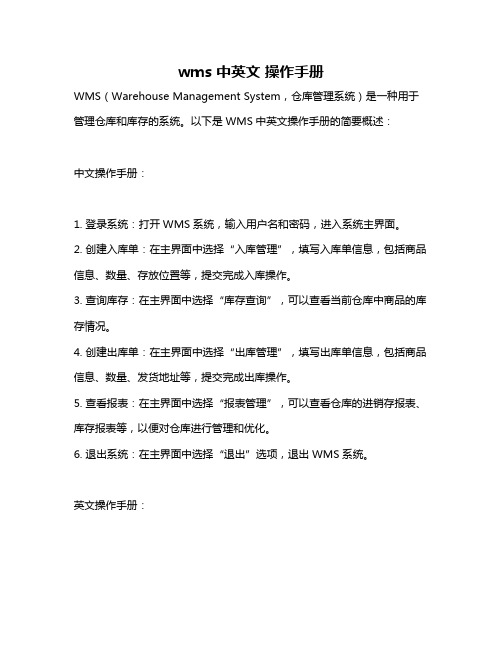
wms 中英文操作手册WMS(Warehouse Management System,仓库管理系统)是一种用于管理仓库和库存的系统。
以下是WMS中英文操作手册的简要概述:中文操作手册:1. 登录系统:打开WMS系统,输入用户名和密码,进入系统主界面。
2. 创建入库单:在主界面中选择“入库管理”,填写入库单信息,包括商品信息、数量、存放位置等,提交完成入库操作。
3. 查询库存:在主界面中选择“库存查询”,可以查看当前仓库中商品的库存情况。
4. 创建出库单:在主界面中选择“出库管理”,填写出库单信息,包括商品信息、数量、发货地址等,提交完成出库操作。
5. 查看报表:在主界面中选择“报表管理”,可以查看仓库的进销存报表、库存报表等,以便对仓库进行管理和优化。
6. 退出系统:在主界面中选择“退出”选项,退出WMS系统。
英文操作手册:1. Log in to the system: Open the WMS system, enter your username and password, and enter the main interface of the system.2. Create an incoming order: Select "Inbound Management" in the main interface, fill in the incoming order information, including product information, quantity, storage location, etc., and submit to complete the inbound operation.3. Query inventory: Select "Inventory Query" in the main interface to view the current inventory situation of the warehouse.4. Create an outgoing order: Select "Outbound Management" in the main interface, fill in the outgoing order information, including product information, quantity, delivery address, etc., and submit to complete the outbound operation.5. View reports: Select "Report Management" in the main interface to view the inventory reports, inventory reports, etc., to manage and optimize the warehouse.6. Log out of the system: Select "Logout" option in the main interface to exit the WMS system.。
WMS仓储管理系统
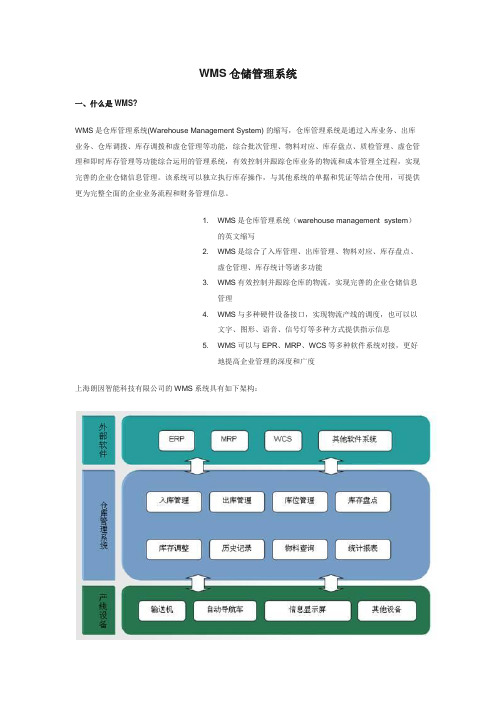
WMS仓储管理系统一、什么是WMS?WMS是仓库管理系统(Warehouse Management System) 的缩写,仓库管理系统是通过入库业务、出库业务、仓库调拨、库存调拨和虚仓管理等功能,综合批次管理、物料对应、库存盘点、质检管理、虚仓管理和即时库存管理等功能综合运用的管理系统,有效控制并跟踪仓库业务的物流和成本管理全过程,实现完善的企业仓储信息管理。
该系统可以独立执行库存操作,与其他系统的单据和凭证等结合使用,可提供更为完整全面的企业业务流程和财务管理信息。
1. WMS是仓库管理系统(warehouse management system)的英文缩写2. WMS是综合了入库管理、出库管理、物料对应、库存盘点、虚仓管理、库存统计等诸多功能3. WMS有效控制并跟踪仓库的物流,实现完善的企业仓储信息管理4. WMS与多种硬件设备接口,实现物流产线的调度,也可以以文字、图形、语音、信号灯等多种方式提供指示信息5. WMS可以与EPR、MRP、WCS等多种软件系统对接,更好地提高企业管理的深度和广度上海朗因智能科技有限公司的WMS系统具有如下架构:二、什么是WCS?WCS 是仓库控制系统(Warehouse Control System) 的缩写。
WCS是介于WMS系统和PLC系统之间的一层管理控制系统。
一方面,它与WMS系统进行信息交互,接受WMS系统的指令,并将其发送给PLC 系统,从而驱动产线产生相应机械动作。
另一方面,它将PLC系统的状态及数据实时反映在界面上,并提供对PLC系统和产线的手动调试接口。
上海朗因智能科技有限公司的WCS系统具有如下通用功能:1、实时监控•支持全局画面显示。
•支持局部放大显示。
•支持实时动态画面。
•停止状态、运行状态、故障状态、禁用状态等按不同颜色或动画显示。
2、参数设置•从PLC读取设备当前参数。
•提供参数设置界面。
•向PLC写入修改后的设备参数。
•支持参数初始化功能。
物流成本仓储管理系统中英文对照外文翻译文献
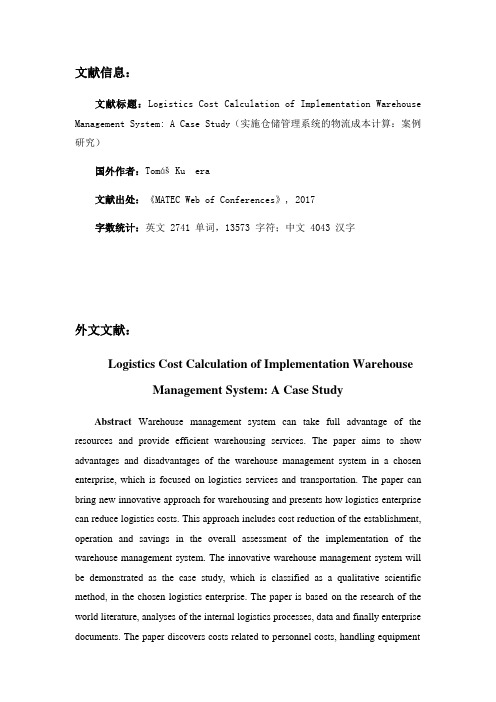
文献信息:文献标题:Logistics Cost Calculation of Implementation Warehouse Management System: A Case Study(实施仓储管理系统的物流成本计算:案例研究)国外作者:Tomáš Ku era文献出处:《MATEC Web of Conferences》, 2017字数统计:英文 2741 单词,13573 字符;中文 4043 汉字外文文献:Logistics Cost Calculation of Implementation Warehouse Management System: A Case StudyAbstract Warehouse management system can take full advantage of the resources and provide efficient warehousing services. The paper aims to show advantages and disadvantages of the warehouse management system in a chosen enterprise, which is focused on logistics services and transportation. The paper can bring new innovative approach for warehousing and presents how logistics enterprise can reduce logistics costs. This approach includes cost reduction of the establishment, operation and savings in the overall assessment of the implementation of the warehouse management system. The innovative warehouse management system will be demonstrated as the case study, which is classified as a qualitative scientific method, in the chosen logistics enterprise. The paper is based on the research of the world literature, analyses of the internal logistics processes, data and finally enterprise documents. The paper discovers costs related to personnel costs, handling equipmentcosts and costs for material identification. Implementation of the warehouse management system will reduce overall logistics costs of warehousing and extend the warehouse management system to other parts of the logistics chain.1.IntroductionAt present time companies try to minimize the costs of logistics. The concept of warehousing is very closely linked to logistics and distribution. Warehousing is within the logistics chain, one of the activities cannot be omitted. Warehousing addresses many crucial issues, inventory levels, ordering cycles, warehouse equipment and their spatial distribution, distribution of warehouse and inventory management. At high inventory levels incurred by companies fixed cost for each additional unit of inventory. Possession of inventory on hand may be necessary for the company due to preserve their source of supply. Warehousing is one of the most important parts of the entire logistics system. Warehousing is a link between manufacturers and customers, it provides storage for many products (e.g. raw materials, parts, semi-finished products, components and finished products). Warehouses allow to bridge space and time. Manufacturing inventories ensure optimal continuity of the production. Inventories of goods for ensuring smooth supply of the final customer.2.Theoretical background and methodologyWith the constant technological advancement, the companies started to invest in new systems to support competitiveness in the market in which they operate. The trend of reducing the cost of warehousing is the maximum use of warehouse space, the minimum number of transfers, effective solution to the warehousing points or reducing the number of species of stored inventory. These costs are significant, if the free warehouse space on someone's rented, or if with a higher warehousing amount of enterprise must pay for additional rented premises, or energy, or heat. Warehousemanagers are usually interested in providing high quality services to their customers at minimum cost. From a tactical, strategic and operational point of view, the main issues concern both the warehouse and the inventory management.Warehousing systems and material handling systems play a pivotal and critical role in the supply chain, and requirements for warehousing and handling operations have significantly increased in recent years.Warehousing refers to activities associated with inventory management. These activities take place within the warehouse area, it is mainly the receipt of goods, purchase goods handling, picking, gathering and activities related to sorting.Warehouse management is not just a purchase, warehousing and transport within the warehouse; this is a more complex system that exceeds the physical boundaries of warehouses. Warehouse Management System (hereinafter WMS) is used to increase performance and warehousing for better management decisions for holding only strictly necessary supplies needed for the manufacturing process. WMS can take full advantage of the resources and provide efficient warehousing services provided by the plan, organize, control and coordination processes. WMS is a necessary approach for every warehouse. An automated warehousing system provides less effort, more efficient, and reliable results compared to manual handled system. WMS is designed to help reduce costs through effective warehouse processes. The tool known as WMS is a system that facilitates the handling operations and storage materials through defined parameters, but the deployment of this system need to go through steps that impact positively and negatively the company's various sectors.The need for automating the warehouse arises from the fact that manual handling may cause human errors which may affect the warehouse utilization.The case study, as one of the qualitative research methods, was chosen because it counts among the most frequently used methods within the research focused on the implementation of different management approaches into practice of organizations.Case study is defined as an empirical survey of the current phenomenon in its natural environment, using multiple sources of evidence. Study cases are selected based on pre- defined conditions of the case.The aim of this paper is to show advantages and disadvantages of the warehouse management system in a chosen logistics service provider (Ewals Cargo Care), which is focused on logistics services and transportation. The paper will bring new innovative approach for warehousing and presents how the logistics enterprise can reduce logistics costs, mainly personnel costs. This is especially thanks to the implementation of warehouse management system. Data used in the case study is based on real logistics processes in logistics service provider. The paper discovers costs related to personnel costs, handling equipment costs and costs for material identification.3.Case study: Warehouse management system in logistics service providerThe case study is focused on new innovative approach for warehousing and presents how logistics service provider (Ewals Cargo Care) can reduce logistics costs, thanks to the implementation of warehouse management system. Ewals Cargo Care (hereinafter ECC) is a transport and logistics company operating in the market for more than 110 years. For its customers, primarily in the automotive, electronics, paper and packaging industry, manufacturers and distributors of consumer electronics provides services both in the field of transport, as well as services related to warehousing and handling of goods.The company's goal is always to find the optimal solution for shipping process on the way from supplier to customer, with the possibility of combining shipment, transhipment or use consolidation warehouses. ECC fully uses its years of experience, skills and knowledge to find and implemented for customers the most effective solution with the least impact on the environment.The case study compares two models. The first one is the existing warehouse system and the second one is the new innovative WMS. For the design of WMS implementation was used analysis of current warehouse management based on fixed warehouse positions and common software that keeps track of inventory about individual stock items. The current system of fixed positions does not allow variable use of empty warehouse cells for current needs income and material warehouse. Proposal for the implementation of WMS in turn allows almost 100% utilization of warehouse capacity and reducing the administrative handling time needed to process goods receipt, put-away, warehousing and distribution of goods to the production. For the current calculation of measured values required for the proposal to introduce managed warehouse was used ECC customer production plan in 2017. Of these production plans, can derive data needed to analyse the personnel and technical complexity in the case of implementation of WMS.Tab. 1 shows the personnel costs in the existing warehouse system. Personnel costs are governed by wage regulation in the ECC. Based on the number of employees (32 people) are determined by the total personnel costs, which amounts to 1,183,000 CZK per month.Table 1. Personnel costs – current state – existing warehouse systemRequired operating personnel warehouse in 2017 could be changed about the implementation of WMS. In tab. 2 lists the personnel costs in the warehouse after implementation of WMS. Out of 32 employees after the implementation of softwareand hardware WMS has been optimized six workers. Personnel costs would be reduced from the amount 1,183,000 CZK to 967,000 CZK per month.Table 2. Personnel costs – state after implementation of WMSIn tab. 3 is an overview of the necessary handling equipment in the warehouse before and after the implementation of WMS. The changes that have occurred since the implementation of WMS are saving one forklift (yellow highlighted box in the tab.3). Number of forklifts can be reduced because WMS reduces the number of forklift drivers. Monthly savings is 24,242 CZK.Table 3. Handling equipment costsTab. 4 shows the hardware and software costs of implementation WMS. These costs include software and hardware equipment (radio frequency terminal equipment, radio frequency network including installation and the necessary printers for printing identification cards). The monthly depreciation of software is 36,944 CZK and maintenance is 7,875 CZK. Monthly depreciation on hardware is 19,168 CZK. Total monthly costs for software and hardware of WMS are 63,987 CZK.Table 4. Hardware and software costs of implementing WMSTab. 5 expresses the logistics costs for material identification in the ECC warehouse. From the available data to determine the total number of printed identification cards (hereinafter IDC) is 660,294 pieces. Print of one IDC worth 0.61 CZK, so they are identifiable costs to the total number of IDC calculated the amount to 402,779 CZK. Costs of hardware and software (column HW and SW) are fixed monthly 29,637 CZK. This amount includes the use of personal computer and printers including consumables. Total yearly costs for material identification are 758,423 C ZK. Table 5. Logistics costs for material identification, HW and SW equipment – existing warehousesystemTab. 6 shows the costs for material identification in case of implementation WMS. IDC costs will change, because new IDCs are cheaper. One identification card costs only 0.24 CZK. Changes that occur with this implementation shall remain in hardware and software. Monthly operating costs of hardware and software of WMSare from tab. 4 totally 63,987 CZK per month. As is apparent from a comparison of the tables, the implementation of WMS will increase the total cost of the material identification from 758,423 CZK to 926,318 CZK per year.Table 6. Logistics costs for material identification, HW and SW equipment – WMSTab. 7 expresses the total cost evaluation, the use of an existing type of warehousing at fixed positions. The right part of the table shows implementation of the WMS. The total savings would be 6 people, so it would reduce personnel costs. WMS could reduce the costs of the warehouse equipment of the forklift. Costs for material identification would increase slightly, but the total yearly cost savings would amount to 2,715,009 CZK.Table 7. Yearly evaluation of total costs4.ConclusionWMS brings many positive impacts. WMS means in practice that all movement of the material is controlled by software, material is identified by a bar code transmitted with a radio frequency terminal. Workers are minimized errors and increasing the productivity. Processes performed by the warehouse staff can monitor and evaluate at any moment. The system minimizes the complaint allows the merging of orders and guarantees compliance with FIFO (First In First Out).The aim of this paper was reduced the logistics costs of warehousing in the ECC and propose the implementation of WMS for reasons of logistics cost savings. With the implementation of WMS will be savings on the cost side. Overall it will be reduced the necessary operating staff consists of 32 to 26 workers, also will be reduced the required handling (warehouse equipment) and slightly will be increased the logistics costs for material identification. Total yearly savings are 2,715,009 C ZK.中文译文:实施仓储管理系统的物流成本计算:案例研究摘要仓储管理系统可充分利用资源,提供高效的仓储服务。
WMS仓储管理系统

WMS仓储管理系统一、什么是WMS?WMS是仓库管理系统(Warehouse Management System) 的缩写,仓库管理系统是通过入库业务、出库业务、仓库调拨、库存调拨和虚仓管理等功能,综合批次管理、物料对应、库存盘点、质检管理、虚仓管理和即时库存管理等功能综合运用的管理系统,有效控制并跟踪仓库业务的物流和成本管理全过程,实现完善的企业仓储信息管理。
该系统可以独立执行库存操作,与其他系统的单据和凭证等结合使用,可提供更为完整全面的企业业务流程和财务管理信息。
1. WMS是仓库管理系统(warehouse management system)的英文缩写2. WMS是综合了入库管理、出库管理、物料对应、库存盘点、虚仓管理、库存统计等诸多功能3. WMS有效控制并跟踪仓库的物流,实现完善的企业仓储信息管理4. WMS与多种硬件设备接口,实现物流产线的调度,也可以以文字、图形、语音、信号灯等多种方式提供指示信息5. WMS可以与EPR、MRP、WCS等多种软件系统对接,更好地提高企业管理的深度和广度上海朗因智能科技有限公司的WMS系统具有如下架构:二、什么是WCS?WCS 是仓库控制系统(Warehouse Control System) 的缩写。
WCS是介于WMS系统和PLC系统之间的一层管理控制系统。
一方面,它与WMS系统进行信息交互,接受WMS系统的指令,并将其发送给PLC 系统,从而驱动产线产生相应机械动作。
另一方面,它将PLC系统的状态及数据实时反映在界面上,并提供对PLC系统和产线的手动调试接口。
上海朗因智能科技有限公司的WCS系统具有如下通用功能:1、实时监控•支持全局画面显示。
•支持局部放大显示。
•支持实时动态画面。
•停止状态、运行状态、故障状态、禁用状态等按不同颜色或动画显示。
2、参数设置•从PLC读取设备当前参数。
•提供参数设置界面。
•向PLC写入修改后的设备参数。
•支持参数初始化功能。
仓储专用中英文对照

仓储专用术语中英文对照仓库管理系统:WarehouseManagementSystem(WMS)alternatetiersrowpattern交错码放AGV无人搬运车??库存:inventoryanchoring膨胀螺丝AS/RS(AutomaticStorageRetrievalSystem)自动存取机/系统自动存取仓储系统自动仓库系统assemblypackaging集合包装averageinventory平均存货battery电瓶beam横撑,横梁beltconveyor皮带式输送机(带)blockpatternrowpattern整齐码放bondedwarehouse国际物流中心保税仓库brickpattern砌砖式码放bufferstock缓冲储备cantilevershalving悬臂架cargofreight货物carrying搬运chainconveyor链条式输送机(带)charger充电机coldchainsystem冷冻链系统commoncarrier公共承运人consolidation装运整合containerterminal集装箱中转站contractcarrier契约承运人contractlogistics契约物流counterbalancetruck平衡式电动(柴油、电动、瓦斯)堆高机cycleinventory周期存货delivery配送depalletizer托盘拆垛机devanning拆箱diagonalbracing斜撑dockleveller月台调整板dockshelter月台门封(充气式,非充气式)double-deeppalletracking双层深式重型物料钢架drive-inpalletracking直入式重型物料钢架drycargo干货dunnage填充electronicdatainterchange电子资料交换EDIexportprocessingzone加工出口区fillrate供应比率floorutilizationpercentage地面面积利用率flow(dynamic)racking重型流力架flow(dynamic)rackshelving轻型(料盒、纸箱)流力架forklifttruck叉车four-wayreachtruck四向式电动堆高机frame支柱组framefeet脚底板framejoint柱连杆freightcontainer货物集装箱generalcargo一般货物handpallettruck油压拖板车horizontalbracing横撑industrialdoor工业门industrialvehicle工业车辆intermodaltransportation复合一贯运输lashing捆扎加固levellingplate垫片LGV激光引导无人搬运车loadefficient装载效率loadingandunloading装卸logisticalutilities物流效用logistics物流materialshandling物料搬运mezzaninesfloor积层架mini-loadAS/RS料盒式自动仓库系统mobiledockleveller月台桥板mobileshelving移动柜netunitloadsize净单元货载尺寸operationarea理货区orderpickingtruck电动拣料车orderpicking指令拣选ordershippedcomplete订货完成率packagedcargo包装货物packaging包装pallet托盘,(木质)栈板palletcontainer栈板笼架palletpoolsystem通用托盘系统palletracking传统式重型物料钢架palletization托盘化palletizer托盘堆垛机palletizingpattern托盘装载方式pickup货物聚集picking拣货,拣选作业pictorialmarkingforhandling货运标识pinwheelpattern针轮式码放planviewsize平面尺寸plasticbin物料盒plasticpallet塑胶栈板platform物流容器,站台,月台physicaldistributionmodel物流标准poweredpallettruck电动拖板车poweredstacker自走式电动堆高机push-backpalletracking后推式重型物料钢架rack货架racknotice标示牌reachtruck前伸式电动堆高机returnablecontainer通用容器rollcontainer笼车rollerconveyor滚筒式输送机(带)safetypin插销safetystock安全储备scrubber洗地机shed临时周转仓库shelving轻量型物料钢架shuttlecar梭车slatconveyor条板式输送机(带)slotted-angleshelving角钢架sorting分类specialcargo特殊货物spotstock现场储备stackercrane自动存取机高架吊车stacking堆垛stockoutfrequency缺货频率storage存储supportbar跨梁surfaceutilizationpercentage表面利用率sweeper扫地机tabletrolley物流台车thirdpartlogistics第三方物流thirdpartylogisticsserviceprovider第三方物流服务商transitinventory中转存货transportation运输transportationpackagesizebymodularcoordination运输包装系列尺寸trayconveyor盘式输送机(带)truckterminal卡车货运站turntable转盘(变更输送方向)unitload单元货载unitloadsystem单元货载系统upright支柱uprightprotctors护脚valueaddednetwork—VAN加值网络vanning装箱verticalconveyor垂直输送机verynarrowaisletruck窄巷道电动堆高机warehouse仓库WCS(WarehouseControlSystem)仓储控制系统WMS(WarehouseManagementSystem)仓储管理系统。
仓储专用术语中英文对照
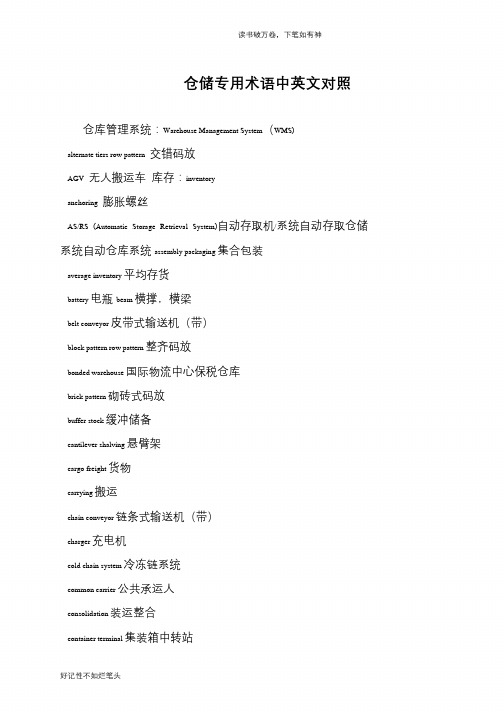
forklift truck叉车four-way reach truck四向式电动堆高机
frame支柱组frame feet脚底板
frame joint柱连杆
freight container货物集装箱
general cargo一般货物
dry cargo干货dunnage填充
electronic data interchange电子资料交换
EDIexport processing zone加工出口区
fill rate供应比率
floor utilization percentage地面面积利用率
flow(dynamic) racking重型流力架
depalletizer托盘拆垛机
devanning拆箱
diagonal bracing斜撑
dock leveller月台调整板
dock shelter月台门封(充气式,非充气式)
double-deep pallet racking双层深式重型物料钢架
drive-in pallet racking直入式重型物料钢架
hand pallet truck油压拖板车
好记性不如烂笔头
读书破万卷,下笔如有神
horizontal bracing横撑
industrial door工业门
industrial vehicle工业车辆
intermodal transportation复合一贯运输
lashing捆扎加固
levelling plate垫片
LGV激光引导无人搬运车
load efficient装载效率
loading and unloading装卸
- 1、下载文档前请自行甄别文档内容的完整性,平台不提供额外的编辑、内容补充、找答案等附加服务。
- 2、"仅部分预览"的文档,不可在线预览部分如存在完整性等问题,可反馈申请退款(可完整预览的文档不适用该条件!)。
- 3、如文档侵犯您的权益,请联系客服反馈,我们会尽快为您处理(人工客服工作时间:9:00-18:30)。
英文原文Warehouse Management Systems (WMS).The evolution of warehouse management systems (WMS) is very similar to that of many other software solutions. Initially a system to control movement and storage of materials within a warehouse, the role of WMS is expanding to including light manufacturing, transportation management, order management, and complete accounting systems. To use the grandfather of operations-related software, MRP, as a comparison, material requirements planning (MRP) started as a system for planning raw material requirements in a manufacturing environment. Soon MRP evolved into manufacturing resource planning (MRPII), which took the basic MRP system and added scheduling and capacity planning logic. Eventually MRPII evolved into enterprise resource planning (ERP), incorporating all the MRPII functionality with full financials and customer and vendor management functionality. Now, whether WMS evolving into a warehouse-focused ERP system is a good thing or not is up to debate. What is clear is that the expansion of the overlap in functionality between Warehouse Management Systems, Enterprise Resource Planning, Distribution Requirements Planning, Transportation Management Systems, Supply Chain Planning, Advanced Planning and Scheduling, and Manufacturing Execution Systems will only increase the level of confusion among companies looking for software solutions for their operations.Even though WMS continues to gain added functionality, the initial core functionality of a WMS has not really changed. The primary purpose of a WMS is to control the movement and storage of materials within an operation and process the associated transactions. Directed picking, directed replenishment, and directed put away are the key to WMS. The detailed setup and processing within a WMS can vary significantly from one software vendor to another, however the basic logic will use a combination of item, location, quantity, unit of measure, and order information to determine where to stock, where to pick, and in what sequence to perform these operations.At a bare minimum, a WMS should:Have a flexible location system.Utilize user-defined parameters to direct warehouse tasks and use live documents to execute these tasks.Have some built-in level of integration with data collection devices.Do You Really Need WMS?Not every warehouse needs a WMS. Certainly any warehouse could benefit from some of the functionality but is the benefit great enough to justify the initial and ongoing costs associated with WMS? Warehouse Management Systems are big, complex, data intensive, applications. They tend to require a lot of initial setup, a lot of system resources to run, and a lot of ongoing data management to con tinue to run. That’s right, you need to "manage" your warehouse "management" system. Often times, large operations will end up creating a new IS department with the sole responsibility of managing the WMS.The Claims:WMS will reduce inventory!WMS will reduce labor costs!WMS will increase storage capacity!WMS will increase customer service!WMS will increase inventory accuracy!The Reality:The implementation of a WMS along with automated data collection will likely give you increases in accuracy, reduction in labor costs (provided the labor required to maintain the system is less than the labor saved on the warehouse floor), and a greater ability to service the customer by reducing cycle times. Expectations of inventory reduction and increased storage capacity are less likely. While increased accuracy and efficiencies in the receiving process may reduce the level of safety stock required, the impact of this reduction will likely be negligible in comparison to overall inventory levels. The predominant factors that control inventory levels are lot sizing, lead times, and demand variability. It is unlikely that a WMS will have a significant impact on any of these factors. And while a WMS certainly provides the tools for more organized storage which may result in increased storage capacity, this improvement will be relative to just how sloppy your pre-WMS processes were.Beyond labor efficiencies, the determining factors in deciding to implement a WMS tend to be more often associated with the need to do something to service your customers that your current system does not support (or does not support well) such as first-in-first-out, cross-docking, automated pick replenishment, wave picking, lot tracking, yard management, automated data collection, automated material handling equipment, etc.SetupThe setup requirements of WMS can be extensive. The characteristics of each item and location must be maintained either at the detail level or by grouping similar items and locationsinto categories. An example of item characteristics at the detail level would include exact dimensions and weight of each item in each unit of measure the item is stocked (each, cases, pallets, etc) as well as information such as whether it can be mixed with other items in a location, whether it is rack able, max stack height, max quantity per location, hazard classifications, finished goods or raw material, fast versus slow mover, etc. Although some operations will need to set up each item this way, most operations will benefit by creating groups of similar products. For example, if you are a distributor of music CDs you would create groups for single CDs, and double CDs, maintaining the detailed dimension and weight information at the group level and only needing to attach the group code to each item. You would likely need to maintain detailed information on special items such as boxed sets or CDs in special packaging. You would also create groups for the different types of locations within your warehouse. An example would be to create three different groups (P1, P2, P3) for the three different sized forward picking locations you use for your CD picking. You then set up the quantity of single CDs that will fit in a P1, P2, and P3 location, quantity of double CDs that fit in a P1, P2, P3 location etc. You would likely also be setting up case quantities, and pallet quantities of each CD group and quantities of cases and pallets per each reserve storage location group.If this sounds simple, it is…well… sort of. In reality most operations have a much more diverse product mix and will require much more system setup. And setting up the physical characteristics of the product and locations is only part of the picture. You have set up enough so that the system knows where a product can fit and how many will fit in that location. You now need to set up the information needed to let the system decide exactly which location to pick from, replenish from/to, and put away to, and in what sequence these events should occur (remember WMS is all about “directed” movement). You do this by assigni ng specific logic to the various combinations of item/order/quantity/location information that will occur.Below I have listed some of the logic used in determining actual locations and sequences.Location Sequence. This is the simplest logic; you simply define a flow through your warehouse and assign a sequence number to each location. In order picking this is used to sequence your picks to flow through the warehouse, in put away the logic would look for the first location in the sequence in which the product would fit.Zone Logic. By breaking down your storage locations into zones you can direct picking, put away, or replenishment to or from specific areas of your warehouse. Since zone logic only designates an area, you will need to combine this with some other type of logic to determine exact location within the zone.Fixed Location. Logic uses predetermined fixed locations per item in picking, put away, and replenishment. Fixed locations are most often used as the primary picking location in piece pick and case-pick operations, however, they can also be used for secondary storage.Random Location. Since computers cannot be truly random (nor would you want them to be) the term random location is a little misleading. Random locations generally refer to areas where products are not stored in designated fixed locations. Like zone logic, you will need some additional logic to determine exact locations.First-in-first-out (FIFO).Directs picking from the oldest inventory first.Last-in-first-out (LIFO).Opposite of FIFO. I didn't think there were any real applications for this logic until a visitor to my site sent an email describing their operation that distributes perishable goods domestically and overseas. They use LIFO for their overseas customers (because of longer in-transit times) and FIFO for their domestic customers.Pick-to-clear. Logic directs picking to the locations with the smallest quantities on hand. This logic is great for space utilization.Reserved Locations. This is used when you want to predetermine specific locations to put away to or pick from. An application for reserved locations would be cross-docking, where you may specify certain quantities of an inbound shipment be moved to specific outbound staging locations or directly to an awaiting outbound trailer.Maximize Cube. Cube logic is found in most WMS systems however it is seldom used. Cube logic basically uses unit dimensions to calculate cube (cubic inches per unit) and then compares this to the cube capacity of the location to determine how much will fit. Now if the units are capable of being stacked into the location in a manner that fills every cubic inch of space in the location, cube logic will work. Since this rarely happens in the real world, cube logic tends to be impractical.Consolidate. Looks to see if there is already a location with the same product stored in it with available capacity. May also create additional moves to consolidate like product stored in multiple locations.Lot Sequence. Used for picking or replenishment, this will use the lot number or lot date to determine locations to pick from or replenish from.It’s very common to combine multiple logic methods to determine the best location. For example you may chose to use pick-to-clear logic within first-in-first-out logic when there are multiple locations with the same receipt date. You also may change the logic based upon current workload. During busy periods you may chose logic that optimizes productivity while during slower periods you switch to logic that optimizes space utilization.Other Functionality/ConsiderationsWave Picking/Batch Picking/Zone Picking. Support for various picking methods varies from one system to another. In high-volume fulfillment operations, picking logic can be a critical factor in WMS selection. See my article on Order Picking for more info on these methods.Task Interleaving. Task interleaving describes functionality that mixes dissimilar tasks such as picking and put away to obtain maximum productivity. Used primarily in full-pallet-load operations, task interleaving will direct a lift truck operator to put away a pallet on his/her way to the next pick. In large warehouses this can greatly reduce travel time, not only increasing productivity, but also reducing wear on the lift trucks and saving on energy costs by reducing lift truck fuel consumption. Task interleaving is also used with cycle counting programs to coordinate a cycle count with a picking or put away task.Integration with Automated Material Handling Equipment. If you are planning on using automated material handling equipment such as carousels, ASRS units, AGNS, pick-to-light systems, or separation systems, you’ll wa nt to consider this during the software selection process. Since these types of automation are very expensive and are usually a core component of your warehouse, you may find that the equipment will drive the selection of the WMS. As with automated data collection, you should be working closely with the equipment manufacturers during the software selection process.Advanced Shipment Notifications (ASN). If your vendors are capable of sending advanced shipment notifications (preferably electronically) and attaching compliance labels to the shipments you will want to make sure that the WMS can use this to automate your receiving process. In addition, if you have requirements to provide ASNs for customers, you will also want to verify this functionality.Yard Management. Yard management describes the function of managing the contents (inventory) of trailers parked outside the warehouse, or the empty trailers themselves. Yard management is generally associated with cross docking operations and may include the management of both inbound and outbound trailers.Labor Tracking/Capacity Planning. Some WMS systems provide functionality related to labor reporting and capacity planning. Anyone that has worked in manufacturing should be familiar with this type of logic. Basically, you set up standard labor hours and machine (usually lift trucks) hours per task and set the available labor and machine hours per shift. The WMS system will use this info to determine capacity and load. Manufacturing has been using capacity planning for decades with mixed results. The need to factor in efficiency and utilization to determine rated capacity is an example of the shortcomings of this process. Not that I’m necessarily against capacity planning in warehousing, I just think most operations don’t really need it and can avoid the disappointment of trying to make it work. I am, however, a bigadvocate of labor tracking for individual productivity measurement. Most WMS maintain enough data to create productivity reporting. Since productivity is measured differently from one operation to another you can assume you will have to do some minor modifications here (usually in the form of custom reporting).Integration with existing accounting/ERP systems. Unless the WMS vendor has already created a specific interface with your accounting/ERP system (such as those provided by an approved business partner) you can expect to spend some significant programming dollars here. While we are all hoping that integration issues will be magically resolved someday by a standardized interface, we isn’t there yet. Ideally you’ll want an integrator that has already integrated the WMS you chose with the business software you are using. Since this is not always possible you at least want an integrator that is very familiar with one of the systems.WMS + everything else = ? As I mentioned at the beginning of this article, a lot of other modules are being added to WMS packages. These would include full financials, light manufacturing, transportation management, purchasing, and sales order management. I don’t see this as a unilateral move of WMS from an add-on module to a core system, but rather an optional approach that has applications in specific industries such as 3PLs. Using ERP systems as a point of reference, it is unlikely that this add-on functionality will match the functionality ofbest-of-breed applications available separately. If warehousing/distribution is your core business function and you don’t want to have to deal with the integration issues of incorporating separate financials, order processing, etc. you may find these WMS based business systems are a good fit.Implementation TipsOutside of the standard “don’t underestimate”, “thoroughly test”, “train, train, train” implementation tips that apply to any business software installation ,it’s important to emphasize that WMS are very data dependent and restrictive by design. That is, you need to have all of the various data elements in place for the system to function properly. And, when they are in place, you must operate within the set parameters.When implementing a WMS, you are adding an additional layer of technology onto your system. And with each layer of technology there is additional overhead and additional sources of potential problems. Now don’t take this as a condemnation of Warehouse Management Systems. Coming from a warehousing background I definitely appreciate the functionality WMS have to offer, and, in many warehouses, this functionality is essential to their ability to serve their customers and remain competitive. It’s just important to note that every solution has its downsides and having a good understanding of the potential implications will allow managers to make better decisions related to the levels of technology that best suits their unique environment.中文译文仓库管理系统( WMS )仓库管理系统( WMS )的演变与许多其他软件解决方案是很像的。
